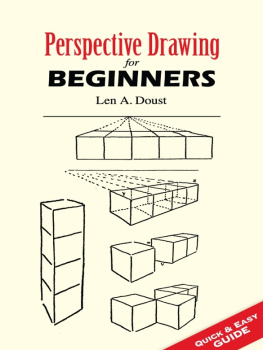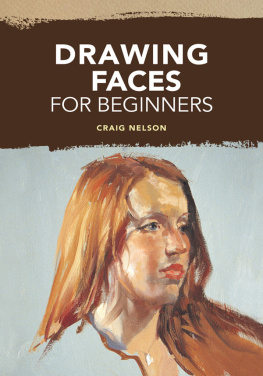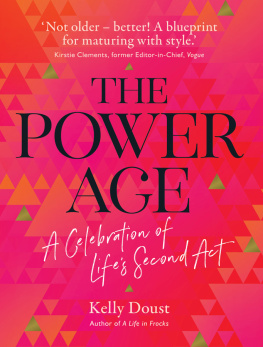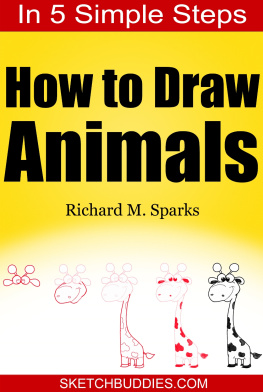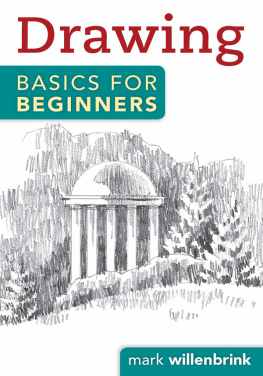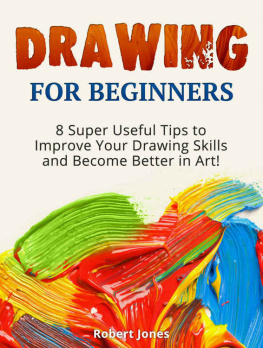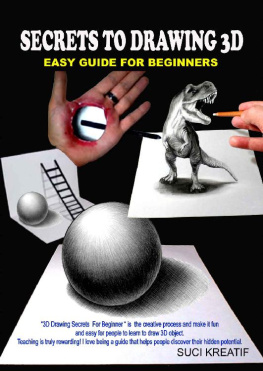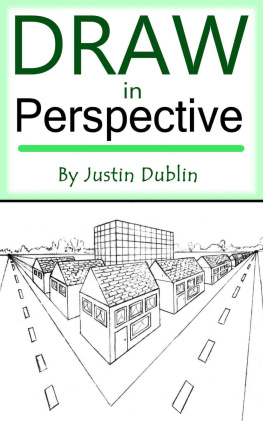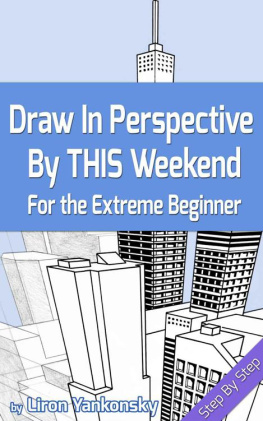Len A. Doust - Perspective Drawing for Beginners
Here you can read online Len A. Doust - Perspective Drawing for Beginners full text of the book (entire story) in english for free. Download pdf and epub, get meaning, cover and reviews about this ebook. year: 2012, publisher: Dover Publications, genre: Home and family. Description of the work, (preface) as well as reviews are available. Best literature library LitArk.com created for fans of good reading and offers a wide selection of genres:
Romance novel
Science fiction
Adventure
Detective
Science
History
Home and family
Prose
Art
Politics
Computer
Non-fiction
Religion
Business
Children
Humor
Choose a favorite category and find really read worthwhile books. Enjoy immersion in the world of imagination, feel the emotions of the characters or learn something new for yourself, make an fascinating discovery.
- Book:Perspective Drawing for Beginners
- Author:
- Publisher:Dover Publications
- Genre:
- Year:2012
- Rating:3 / 5
- Favourites:Add to favourites
- Your mark:
- 60
- 1
- 2
- 3
- 4
- 5
Perspective Drawing for Beginners: summary, description and annotation
We offer to read an annotation, description, summary or preface (depends on what the author of the book "Perspective Drawing for Beginners" wrote himself). If you haven't found the necessary information about the book — write in the comments, we will try to find it.
Perspective Drawing for Beginners — read online for free the complete book (whole text) full work
Below is the text of the book, divided by pages. System saving the place of the last page read, allows you to conveniently read the book "Perspective Drawing for Beginners" online for free, without having to search again every time where you left off. Put a bookmark, and you can go to the page where you finished reading at any time.
Font size:
Interval:
Bookmark:
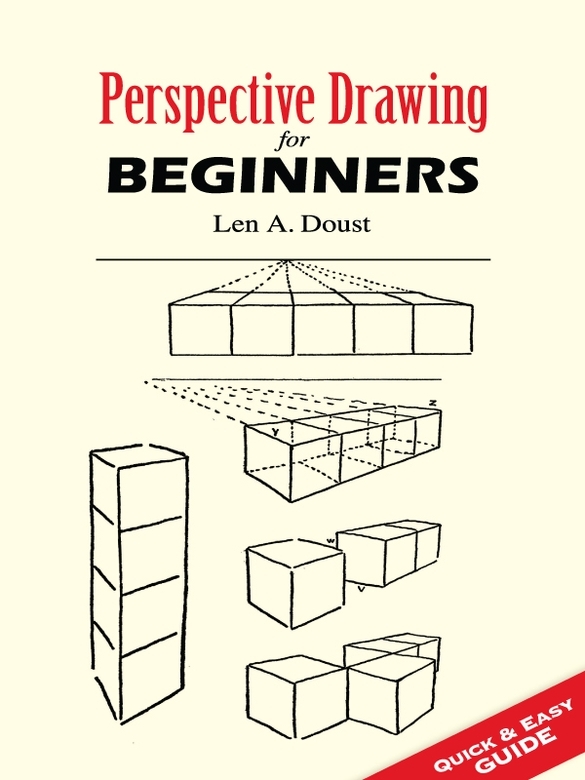
OF all the difficulties that hamper the speedy efficiency of an amateur artist, perspective is the most general and obstinate. The books which I have been privileged to publish on sketching, drawing, and painting have brought to me hundreds of letters, many of appreciation I am happy to say, but mostly prompted by a desire to know more. Let me speak plainly here.
If my earnest and energetic readers would thoroughly master the books even to the extent of many readings, I should receive many less letters of inquiry and, I hope, more of appreciation. In nine cases out of ten I have to repeat certain portions of the book with which my correspondent is so delighted. All teachers find that severity is an essential quality.
Well, I dare not be severe with you who read my books or you will buy no more, perhaps, and then my publishers would not like me. But, believe me, not one word of these little guides has been written carelessly or to make up the number, and all I ask is that you do not pass over a page until completely understood and that you do not neglect the book until you know all it contains. Not that the knowledge is rare, but it is to a great extent essential and, I firmly believe, valuable.
Dozens of go-aheads write to me about perspective. They want simple principles and rules by which they can quickly sketch sea, town, and country. This book is not a textbook on perspective. There are many complete studies of the subject. Here I have tried to give you short cuts to sound drawing for pictorial purposes and not for architectural designs.
I suppose that everyone knows what is perspective. All who have tried to draw even in the slightest degree know that objects appear to get smaller as they recede, but many have not the slightest idea what rules govern such an illusion and their variation under different circumstances. Hold your finger close to your eye, shutting the other, and see how much is hidden. Hold your pencil up in line with a distant tree and you find they appear equal in thickness. Why is it that the feet of a tables legs are not in a line? If railway lines tend to join one another in the distance, how is one to estimate their slope? Where does one place the horizon? How does one draw two sides of a house in order to make it look true? These are a few of the many questions buzzing in the beginners brain.
The main difficulty is caused by the unquestionable and all-important fact that you must not draw things as you know they are, but as your eye registers them. You know full well that the railway lines do not draw nearer to one another, for the resulting mishap to the train would wreck it as surely as your picture will be wrecked if you draw the lines parallel.
Tell me not in mournful numbers... that things are not what they seem, wrote Tennyson. Well, mournful news it may be to the beginner in art, but things certainly are not what they seem. The artist is concerned with what they seem. If parallel lines seem to join, you must join them; if horizontal lines seem tilted, you must tilt them; just as in the realm of colour, if a brown door appears purple, purple you must paint, and if green grass appears blue or grey, then do not make it green.
I have said enough, I hope, to whet your appetite and inspire a mite of curiosity for this weird world of contradictions into which we are going to step. Round lines nearly straight, a mile dwindling suddenly to an inch or two, a perfectly sober horizontal line leaping skywards, hands becoming bigger than houseswhat a delicious world for Mr. Chesterton to plunge and splash in! And all under the dreaded, horrid word perspective. But, as in all fairy tales there are certain laws, passwords, and magic rules, so in perspective there are a few simple principles which, once grasped, will open up a riotous mass of shapes and forms never before seen.
THE secret of the railway lines is our first mystery story. But as in most mystery stories, having discovered the facts of the case, that the lines appear to meet and yet in reality do not, we must start from another angle.
The first thing to establish when you intend to draw anything in perspective is your eye level. When I say anything in perspective, I mean any line that goes away from you. Vertical lines, generally speaking, remain vertical to us. That is to say, two corners of a house or two vertical poles do not appear to meet as do railway lines. See Plate I, Fig. A. Also two lines running parallel to our eyes as drawn at Fig. B do not appear to join. Only lines going away from us, whatever their angle, seem to meet. See Fig. C.
Let us return to the eye level. This is the level of your eye and should be represented on paper by a straight line from side to side. The position of this line on the paper is one for you to decide upon, but when sketching out of doors it will be essential for you to remember that this line is identical with the horizon. On Plate 2 I have briefly sketched three views showing first that the horizon, or where sky and sea meet, is on the eye level, secondly, that mountains and foreground may hide the actual horizon, thirdly, that when the distance is flat it is practically level with the eye line.
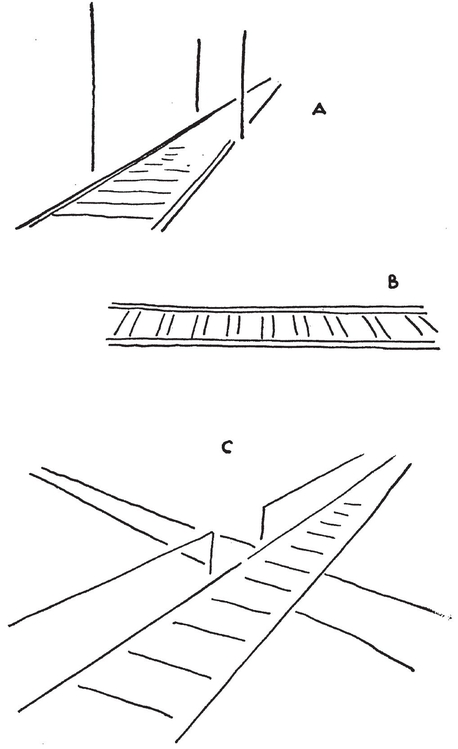
PLATE 1
The figure in each of these sketches is supposed to be the artist himself. If he stood up his eye level obviously would rise, but so also would the horizon. This is quite obvious when I explain that all lines not vertical or parallel with the artist (see Plate I, Figs. A and B) slope towards the eye level. For example, our railway lines on Plate I will meet at the eye level. But they will also meet at the horizon for the simple reason that they cannot mount into the sky, being earth-bound.
Having thoroughly grasped the two facts that the eye level is the horizon, if you can see it, and that all going-away lines meet at the eye level, you are sufficiently advanced to tackle a very simple object.
I choose a gate as an illustration because it is, in its simple shape, a rectangle. Hence, although I teach you by means of an object, the mathematical outlook is not confused. On Plate 3, Fig. A, I have sketched a five-barred gate, a bush, and my eye level when standing; below at Fig. B, I repeat the drawing with eye level when I am seated. At Figs. C and D you have a going-away view of the gate with similar eye levels to Figs. A and B. Let us analyse Fig. C.
First, you will notice that the horizontal bars of the gate are all sloping upwards, although you know that they are in reality parallel with the ground and with your eye level. Next you will notice that they meet, when extended, at the spot marked Z. This spot Z is the key-spot to all perspective drawing. It is the spot where all lines parallel to the top gate-bar meet. For example, the lines of the path edge which runs parallel with the gate also meet at this spot.
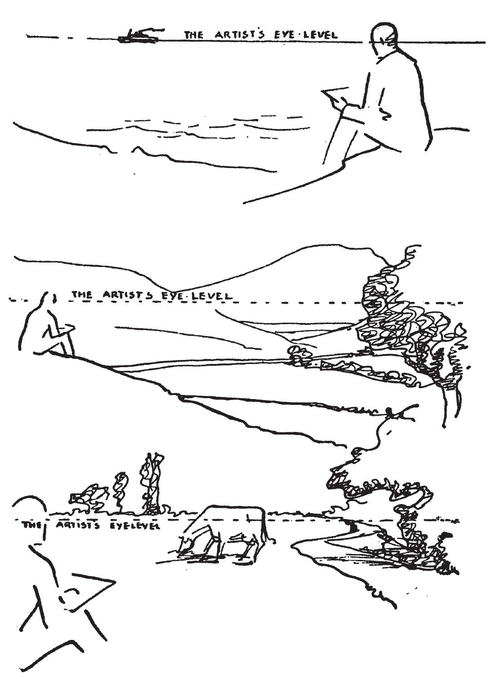
PLATE 2
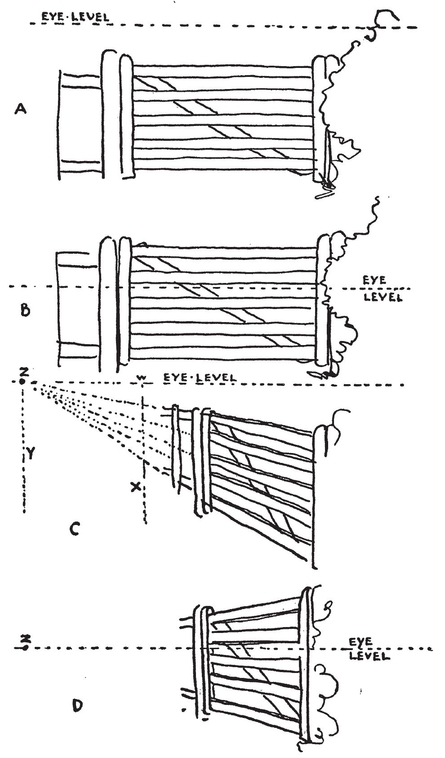
PLATE 3
The obvious question you are asking is, How does one find such a spot? In strict perspective there are mathematical rules for obtaining this spot. It varies according to your own position. If you are gazing in a parallel line to the gate, that is to say, if your head and shoulders are set at right angles to the gate and, when you look straight ahead, the path of your eyes is as shown at line Y, the spot Z is where this line intersects your eye-level line. But supposing the path of your straight view to be X, then you are opposite to the point W of your eye level. In any such case, where you are not sitting parallel with the horizontal object to be drawn, the method to be used by the landscape artist is more usual and is as follows.
Font size:
Interval:
Bookmark:
Similar books «Perspective Drawing for Beginners»
Look at similar books to Perspective Drawing for Beginners. We have selected literature similar in name and meaning in the hope of providing readers with more options to find new, interesting, not yet read works.
Discussion, reviews of the book Perspective Drawing for Beginners and just readers' own opinions. Leave your comments, write what you think about the work, its meaning or the main characters. Specify what exactly you liked and what you didn't like, and why you think so.

